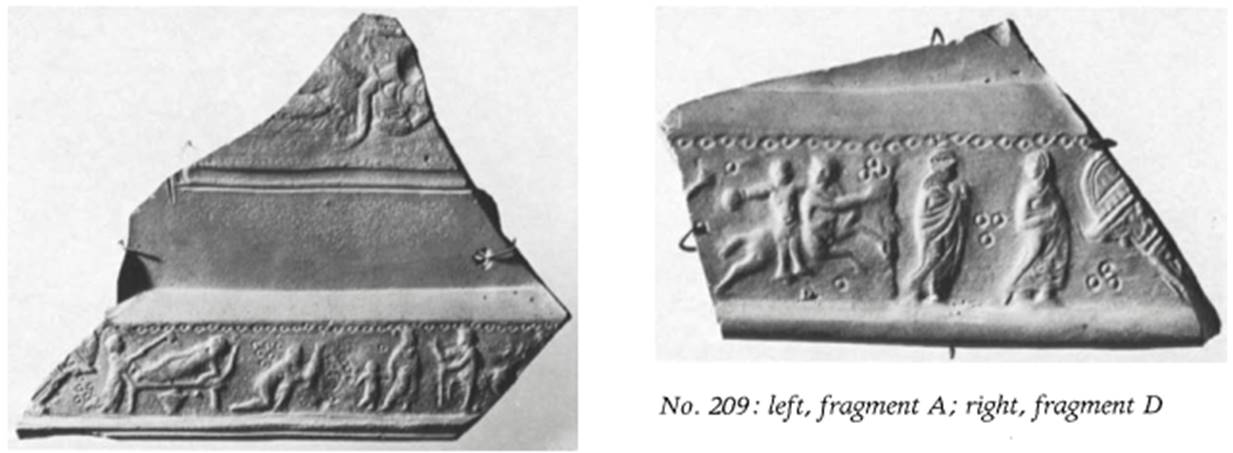Fragments of plates with scenes from the life of Achilles. North Africa, about 400-430. Redware
The ten fragments belonged to rectangular red- ware plates. The flat rims were decorated with figurative relief scenes (fragments A through I), and there was also a larger rectangular scene at the center of the plates (A, J). The rim reliefs depict consecutive episodes in the life of Achilles from his birth to the ransoming of Hector's body. A: at the left is Thetis, evidently in labor; she is fanned by a servant and under the bed is a bowl in which the newborn baby will be washed (cf. nos. 207, 208, 213). The next scene on the same fragment is abbreviated, perhaps misunderstood: Thetis kneels, dipping Achilles into the Styx, but he is curiously wrapped in swaddling clothes (cf. nos. 207, 208).

At the right Thetis takes Achilles to Cheiron, whose cloak flies out behind him (understood as wings ?; cf. nos. 208, 210). B: a fresher impression of the birth scene. C: mealtime; Cheiron offers Achilles a rabbit (cf. no. 208, scene 4). D: hunting; Achilles astride Cheiron. The figures at the right may belong to E: the locale is now the court of Lykomedes on Skyros; the disguised Achilles plays the lyre in the presence of two of the king's daughters (cf. no. 208). The next episode begins at the right and continues on fragment F: Deidamia kneels, as Achilles reveals his identity by seizing the arms; Odysseus gestures at the right. G: Thetis rides over the sea in the company of Nereids (or Tritons?); a Nereid (see H) swims in front, holding a helmet.
The subject is the return of Thetis from the forge of Hephaestus, with new armor for Achilles. H: at the left is the helmet; at the right are two groups of three persons (for the second, see also I). The subject here is uncertain; the scene must precede Priam's embassy to Achilles (J), and most of the figures are women. They may represent Hector's mother and sisters, at the moment of Priam's departure for the tent of Achilles. J: only the figure of the supplicating Priam is preserved; on A there is a part of Briseis. A better- preserved plate in the Musee National du Bardo at Tunis (Salomonson, 1962, pi. xxiv, no. 1) was made with the same mold and shows that the subject of the central relief scene is the famous encounter of Priam and Achilles, when the old king comes to beg for the body of his son Hector (cf. also no. 196, scene 3).
The redware relief plates are the modest craft products of North African workshops of the early fifth century (Salomonson, 1962, pp. 87-90). They imitate silver models (cf. the Corbridge lanx, no. 110), and the molds used for the relief scenes were no doubt originally taken from such metal archetypes. However, the indistinct relief scenes of A through I must have been made from molds that were themselves taken from moldmade terracotta plates and not from the crisper metal models. Although the scenes are often abbreviated and unclear, they can still be seen to reflect the same iconographic model as the silver plate no. 208 and the other related works.
The individual figures were made in separate molds, so it was easy enough for the artisan to leave out elements if space was insufficient. Other redware plates have Christian subjects, and, in a few cases, the Achilles cycle seems to have been influenced by Christian motifs, as in the scene of the presentation of Achilles to Cheiron; Thetis leads the little boy by the hand, just as Hannah leads Samuel to Eli in an illustrated Byzantine Books of Kings.
The Benaki fragments were all purchased in Alexandria. Bibliography: Weitzmann, 1959, pp. 56-57; Salomonson, 1962, pp. 73-81; Hayes, 1972, pp. 211-217.
Date added: 2025-08-31; views: 74;
